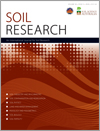Local soil knowledge (LSK) is broadly known for its importance and contribution to the sustainability of soil management in farming practices. However, this field remains largely unknown to the scientific community, so it is timely to review what advances have been made in LSK research and the grey literature in recent years. This review examines if the trends observed in published articles before 2003 have been successfully resolved, or if new issues have emerged that require further study.

Soil Research
Volume 58 Number 3 2020
Nitrous oxide (N2O) is a major greenhouse gas. We investigated whether replacing poultry litter with inter-row legumes in coppiced tea tree plantations could lower soil N2O emissions at three field sites. The N2O emissions in coppiced tea tree systems under current management practices were very low, offering limited potential to lower seasonal N2O emissions through management practice change.
SR19174Integration of vis-NIR and pXRF spectroscopy for rapid measurement of soil lead concentrations
Portable X-ray fluorescence (pXRF) and visible near-infrared (vis-NIR) spectroscopy predict heavy metal concentrations in soil more rapidly and in a less hazardous manner than traditional laboratory analytical methods. To improve accuracy of these sensors, using lead as the target variable, different data treatments and models were compared, including combination of the outputs from both instruments. The most accurate predictions were obtained by Granger–Ramanathan model averaging of vis-NIR Cubist model predictions and Compton-normalised pXRF output.
The effects of mixed inorganic and organic nitrogen (N) addition on soil enzyme activities and the underlying mechanism remain unclear, especially in complex field conditions. The different forms of N deposition showed variable effects on soil hydrolytic enzyme activities. These findings provide a good understanding of the response trends of soil hydrolytic enzyme activities in a meadow steppe to changes in N deposition rate and form.
SR19170Targeting changes in soil porosity through modification of compost size and application rate
Globally, there is an increasing dependency on irrigation to produce food; however, production on some soils is limited by their ability to hold water. This study demonstrates that the modification and incorporation of municipal compost (MC) into soil can result in targeted changes in soil pore size. Incorporating larger MC particles creates larger pore spaces (increasing drainage), while smaller MC particles create smaller pores (increasing water retention). This practice has the potential to address urban waste disposal problems and improve water use efficiency of irrigated land.
Increasing nitrogen (N) storage in degraded tropical soils can enhance agricultural productivity and sustainability while also reducing N loss into groundwater and the atmosphere. Reducing soil disturbance (e.g. zero tillage) and adding organic material can increase soil N storage. However, easily-decomposable leguminous organic amendments (e.g. green manures) lose more N when disturbed than do other, more recalcitrant non-leguminous residues (e.g. tree litter). Using cultivation methods that minimise soil disturbance is recommended to increase N storage under legume amendments.
When manure is used as a source of phosphorus (P) in agricultural soil, the changes in P availability differ compared to those that occur with addition of mineral fertilisers. Organic fertilisers such as manures improve soil quality and increase P availability to plants, resulting in a lower demand for mineral P fertilisers and increases in sustainability and yields. Dairy manure resulted in higher P availability compared with mineral fertiliser and can be used as an alternative source of P to plants.
Highly weathered tropical soils have high capacity to adsorb phosphate due to the predominance of iron and aluminium oxides, decreasing the availability of phosphorus in the soil. Information concerning how enhanced-efficiency phosphate fertilisers interfere with the diffusive flux of phosphorus in oxidic soils is scarce in the literature. The use of enhanced-efficiency fertilisers may be an alternative to maintain the diffusive flux of phosphorus in the soil over long periods and consequently P availability.
SR19156Relief and edaphoclimatic conditions as influencing agents of CO2 release in Alagoas Caatinga, Brazil
 , Kallianna Dantas Araujo
, Kallianna Dantas Araujo  , Mayara Andrade Souza
, Mayara Andrade Souza  , Danúbia Lins Gomes
, Danúbia Lins Gomes  , Elba dos Santos Lira
, Elba dos Santos Lira  , Sinval Autran Mendes Guimarães Júnior
, Sinval Autran Mendes Guimarães Júnior  and João Gomes da Costa
and João Gomes da Costa 
Soil respiration is a means by which the release of carbon dioxide (the main greenhouse gas) into the atmosphere occurs. The release of this gas occurs due to the influence of vegetation, moisture, rainfall and relief (still little studied). Results show that the release of carbon dioxide was higher in half-slope and shoulder areas (steeper positions on a slope) and increased with availability of soil water.
SR19260Surface-positioned double-ring to improve traditional infiltrometer for measuring soil infiltration
The infiltrability of soil, usually referred to as the infiltration flux of water at the soil surface, plays an important role in hydrological circulation of water. A traditional double-ring infiltrometer was hammered into soil to a depth of 5–15 cm to measure soil water infiltration, causing soil disturbance and water leakage. A surface-positioned double-ring infiltrometer, placed on soil surface, was suggested to improve measurement accuracy and experimental results demonstrated that it did improve accuracy.



